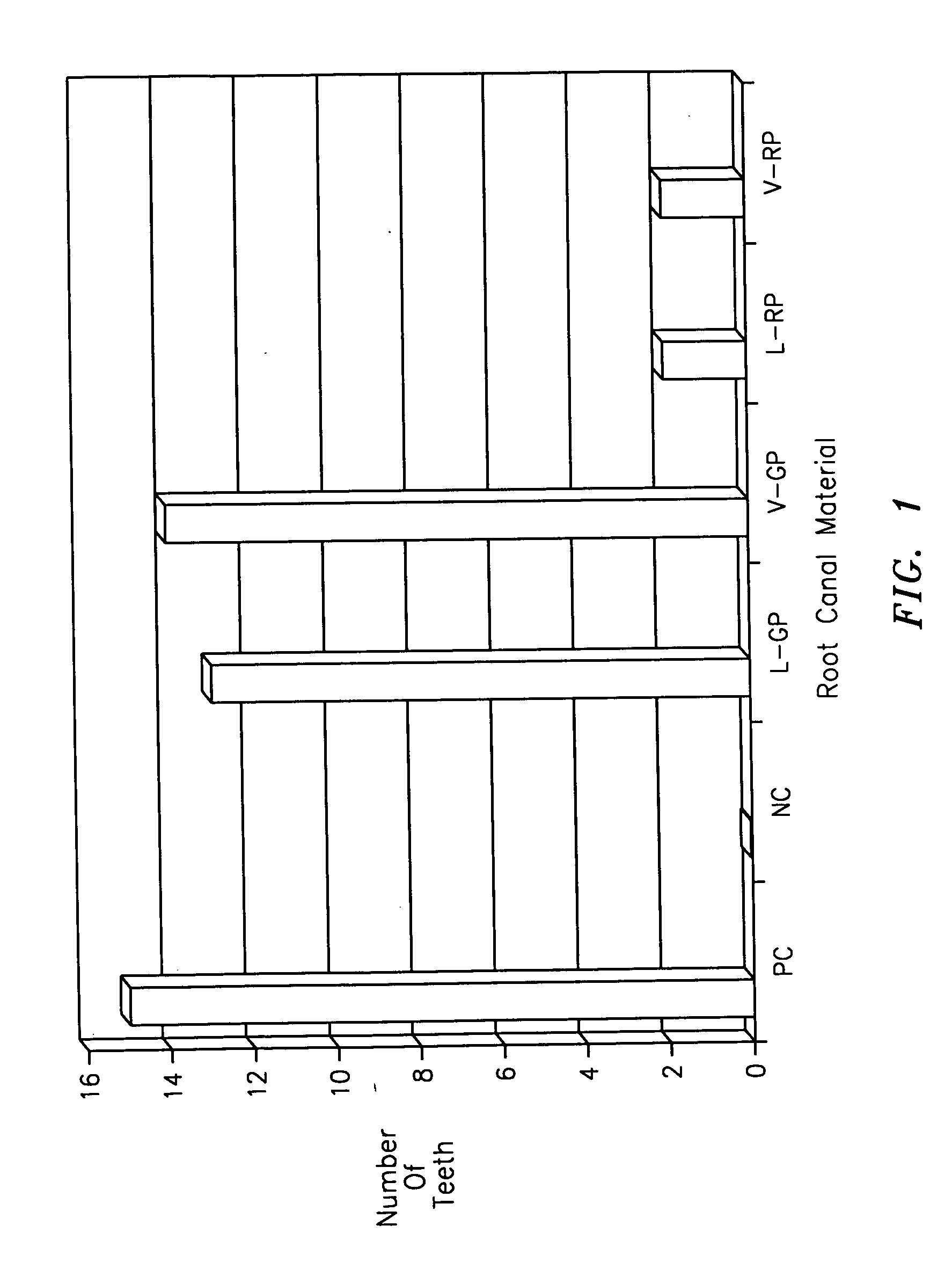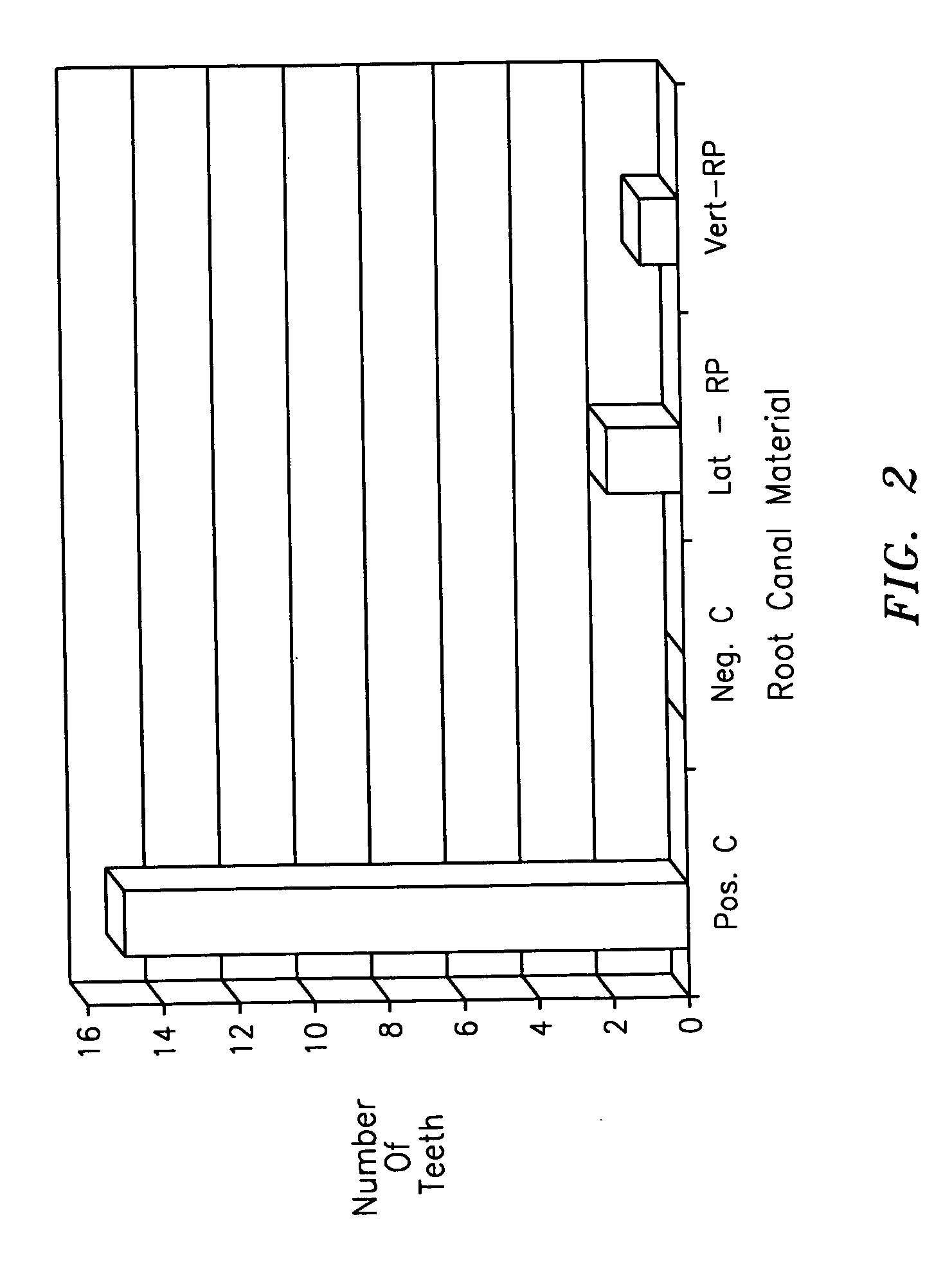Dental filling material
- Summary
- Abstract
- Description
- Claims
- Application Information
AI Technical Summary
Benefits of technology
Problems solved by technology
Method used
Image
Examples
example 1
[0043] Extracted central incisor teeth were prepared with root canal files to standard sizes so that the remaining walls of the teeth were of a similar size. The roots were restored as follows Group 1 (15 teeth)−positive control —no root canal filling placed. Group 2 (15 teeth)−root canals filled with lateral condensation gutta-percha and AH26 sealer. Group 3 (15 teeth)—root canals filled with vertical condensation gutta-percha and AH26 root canal sealer. Group 4 (15 teeth)−root canals walls were prepared with the self etch primer, filled with root canal sealant sealer and then filled vertically with resin percha in accordance with the invention. All roots were placed in a container with 100% humidity for 2 weeks until the strength tests were performed. After two weeks the teeth were mounted into a plastic ring with commercial resin to a level that left 8 mm of root above the resin. The rings were mounted into an Instron machine in which a ball attachment was placed so as to create ...
example 2
[0045] A composition comprising polycaprolactone available from Union Carbide in an amount of about 40%, a bioactive glass having a composition similar to Bioglass™ (available from by U.S. Biomaterials) in an amount of about 30%, USP grade zinc oxide in an amount of about 20% and barium sulfate as a radio-opacifying agent in an amount of about 10% was manufactured. The method of forming the composition involved heating the polycaprolactone at about 70° C. to a softened state. The remaining ingredients were then added and mixed under the action of kneading, pressing, or mixing to blend into the polycaprolactone completely to form a homogenous dough. The formed compound was then ready for application to the carrier device.
example 3
[0046] A composition comprising polycaprolactone in an amount of about 30%, caprolactone (methacryloxy)ethyl ester (CMEE) in an amount of about 10%, tricalcium phosphate in an amount of about 30%, and zirconium oxide in an amount of about 10% was manufactured. The method of forming the composition involved heating the polycaprolactone (available from Union Carbide) at about 70° C. to a softened state. The remaining ingredients were then added and mixed under the action of kneading, pressing, or mixing to blend into the polycaprolactone completely to form a homogenous dough. The formed compound was then ready for application to the carrier device.
[0047] The following Table 3 sets forth examples of the filling material compositions made similar to the methods described in Examples 2 and 3 above.
TABLE 3CompositionWEIGHT (%)ABCDEP767*40302125P787*927PEGDMA(400)58UDMA10CMEE**10Bioactive glass301021.530ZnO201021.52525BaSO4202220BiOCl10Ca(OH)220Ca3(PO4)220ZrO210
*P767 and P787 are polyca...
PUM
| Property | Measurement | Unit |
|---|---|---|
| Fraction | aaaaa | aaaaa |
| Fraction | aaaaa | aaaaa |
| Time | aaaaa | aaaaa |
Abstract
Description
Claims
Application Information
 Login to View More
Login to View More - R&D
- Intellectual Property
- Life Sciences
- Materials
- Tech Scout
- Unparalleled Data Quality
- Higher Quality Content
- 60% Fewer Hallucinations
Browse by: Latest US Patents, China's latest patents, Technical Efficacy Thesaurus, Application Domain, Technology Topic, Popular Technical Reports.
© 2025 PatSnap. All rights reserved.Legal|Privacy policy|Modern Slavery Act Transparency Statement|Sitemap|About US| Contact US: help@patsnap.com



